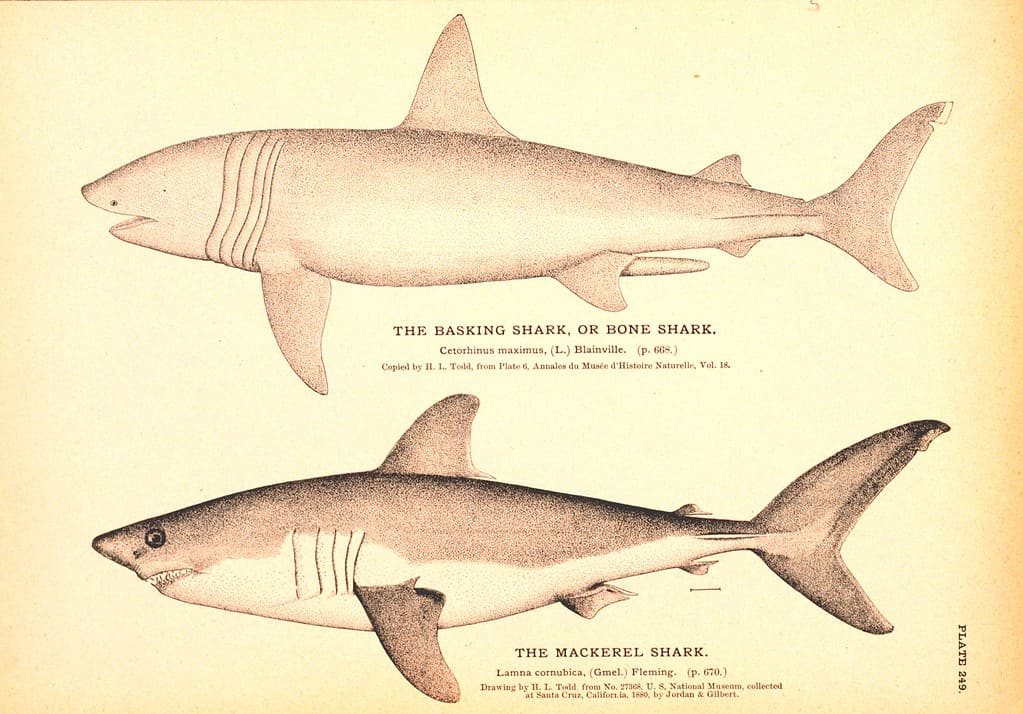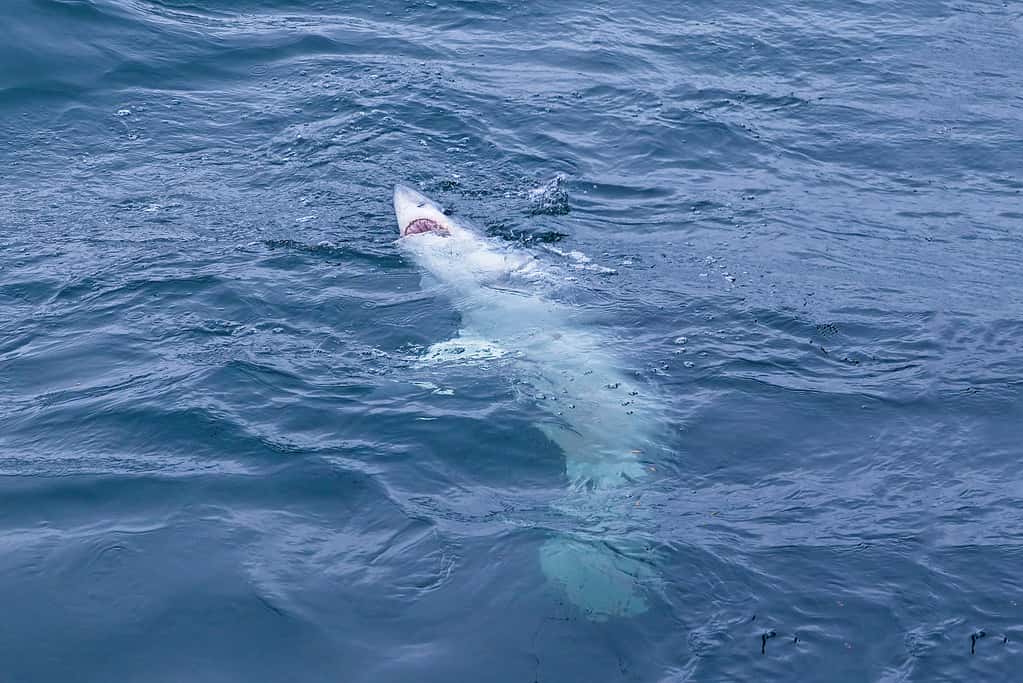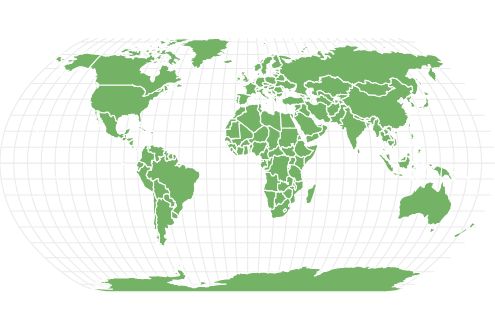The porbeagle is one of the few sharks that jumps out of the water
Advertisement
Porbeagle Shark Scientific Classification
- Kingdom
- Animalia
- Phylum
- Chordata
- Class
- Chondrichthyes
- Order
- Lamniformes
- Family
- Lamnidae
- Genus
- Lamna
- Scientific Name
- Lamna nasus
Read our Complete Guide to Classification of Animals.
Porbeagle Shark Conservation Status
Porbeagle Shark Facts
- Prey
- Bony fish, squid, shell fish, and sharks
- Group Behavior
- Solitary
- Fun Fact
- The porbeagle is one of the few sharks that jumps out of the water
- Estimated Population Size
- Unknown
- Biggest Threat
- Overfishing
- Most Distinctive Feature
- The massive, blade-like teeth
- Other Name(s)
- Atlantic Mackerel Shark, Bottle-nosed Shark, and Blue Dog
- Gestation Period
- 8 to 9 months
- Habitat
- Oceans
- Predators
- Humans
- Diet
- Carnivore
- Type
- Shark
- Common Name
- Porbeagle Shark
- Number Of Species
- 1
View all of the Porbeagle Shark images!

The porbeagle shark is a powerful predator that stalks the world’s deepest oceans in pursuit of prey with its high speed.
As the name suggests, this species has reminded people of a beagle for its incredible endurance and a dogged ability to chase down prey. The streamlined body and long gill slits are adaptations suited for this highly active lifestyle.
5 Incredible Porbeagle Shark Facts!

The porbeagle shark has to always be moving for it to be able to breathe.
©ANPerryman/ via Getty Images
- The porbeagle must remain in constant motion to breathe correctly.
- The porbeagle migrates long distances, sometimes more than 1,000 miles, to reach feeding or mating grounds.
- The porbeagle shark has been seen jumping out of the water in pursuit of prey. Only a few other types of sharks exhibit this behavior.
- The porbeagle has the ability to detect electrical fields in the water.
- The porbeagle is known to exhibit playful behavior. They appear to ram floating objects with their snout and chase other members of the same species for fun.
Classification and Scientific Name
The scientific name of the porbeagle shark is Lamna nasus. The genus of Lamna, which includes only one other living species (the salmon shark), was probably named after the fierce mythological Greek monster, the Lamia. Nasus is a Latin word meaning nose. This species belongs to the Lamnidae family of mackerel or white sharks. It is somewhat closely related to the great white shark and mako shark.
Evolution and Origins
Porbeagle sharks live in the North Atlantic, southern Atlantic, Indian, and Pacific Oceans. They’re not seen in the North Pacific, but their similar relative, the salmon shark, lives there. Porbeagles like colder waters and can swim really deep, even down to 2,300 feet.
Quick and full of energy, the porbeagle shark can be spotted alone or in groups. Its streamlined body, slim tail base with side ridges, and curved tail are all built for maintaining speed. These adaptations have also emerged separately in tunas, billfishes, and other fast-swimming fish.
Furthermore, the name “porbeagle shark” is thought to come from blending “porpoise” and “beagle,” which describes its round shape and determined hunting tactics. These sharks are extremely active and possess strong bodies, enabling them to undertake seasonal migrations for feeding and reproduction.
Appearance

The porbeagle is a muscular shark with a spindle-like shape.
©NOAA’s Historic Fisheries Collection, Public domain, via Wikimedia Commons – License
The porbeagle is a muscular shark with a spindle-like shape. It is characterized by a blue-gray body and a white stomach area. One distinguishing feature that sets it apart from closely related species is the blue-gray dorsal fin with a white mark on the rear base. This species has a typical length of 5 to 12 feet. Females are slightly larger than males on average, while Atlantic sharks tend to grow larger than Pacific sharks.
Porbeagle Shark vs. Mako
The porbeagle and mako sharks are easy to mistake for each other. They belong to the same family of Lamnidae but not the same genus. While they do look similar, the porbeagle exhibits a few subtle differences, including a grayer color, a shorter pectoral fin, and the presence of a secondary keel on the tail fin (the keel is a small ridge that strengthens the connection between the body and tail).
Each tooth also has two small cusplets on the sides. The cusplets are like small projections from the base of the tooth.
Distribution, Population, and Habitat

Porbeagle shark prefers the cold waters of the North Atlantic Ocean as well as other cold seas.
©birdsonline/ via Getty Images
The porbeagle shark is found in the cold and temperate waters of the North Atlantic, the Mediterranean Sea, and parts of the South Pacific, including the coasts of Australia and South Africa. It shifts between shallow and deep water depending on the season or time of day.
While population numbers are not known, this species has fallen dramatically from its peak as a result of overfishing. Some areas contain only 10% of their original shark numbers. It is currently considered to be a vulnerable species by the IUCN Red List on account of its slow maturity and the threats they face.
Predators and Prey
The porbeagle shark is considered an apex predator in its native habitat. It stalks prey over long distances and also feeds near the bottom of the sea. The top speed of 20 miles per hour is inferred from the study of closely related species.
What eats them?
Besides humans, the porbeagle does not have any known predators in the wild. Great white sharks and killer whales are considered possible predators, but to date, there is no record of predation occurring with these species.
What do they eat?
The porbeagle consumes all kinds of bony fish such as herring, sardines, and mackerel. Its diet also consists of squid, shellfish, and other sharks. This is an opportunistic feeder that will consume almost anything.
Reproduction and Lifespan
Porbeagle sharks gather together at their mating grounds between September and November. One shark will typically have multiple partners throughout the breeding season. The male will bite onto the female’s pectoral fins and flanks for stability during copulation, which can leave behind deep scars. After a gestation period lasting eight to nine months, the mother only gives birth to one to five pups at a time.
The porbeagle has an ovoviviparous reproductive strategy. The unborn sharks will hatch inside of the mother’s uterus and then feed on the unfertilized eggs while still in the womb. It is not known how much if any parental care is provided to the young, but males reach sexual maturity around eight years, while females reach sexual maturity around 13 years of age. The typical lifespan is somewhere between 25 to 46 years in the wild.
Fishing and Cooking
The porbeagle is highly sought after both for the value of its meat and the prestige of hunting it. They are caught with longlines, gill nets, and trawls, both accidentally and on purpose. Ranked among the most desirable of any shark species, the meat is sold fresh, frozen, salted, or dried. Europe appears to be the largest market, but it’s also used for shark fin soup in East Asia. The rest of the shark is used for leather, oil, and fishmeal.
View all 192 animals that start with PPorbeagle Shark FAQs (Frequently Asked Questions)
What is a porbeagle shark?
The porbeagle is a large deep-water predator with a large, muscular, blue-gray body. It is a member of the mackerel or white shark family. They are top predators in many cold and temperate oceans around the world.
Where are porbeagle sharks found?
The porbeagle is mostly found in the North Atlantic and parts of the South Pacific.
Do porbeagle sharks attack humans?
It’s hard to give an exact number of shark attacks, because the porbeagle may be misidentified as another species, but only a few attacks on humans have ever been documented.
Are porbeagles dangerous?
Despite its fearsome look and enormous size, the porbeagle is not generally known to attack humans. But if it did attack a human, it would obviously pose an immense danger, because it can easily kill a person.
What do porbeagle sharks eat?
The porbeagle’s diet consists of bony fish, squid, shell fish, and other sharks.
How big do porbeagle sharks get?
The largest porbeagle shark ever recorded was about 12 feet in length and 500 pounds. Most members of this species aren’t much more than 7 or 8 feet in length and 300 pounds.
What is the gestation period for the oceanic porbeagle shark?
The porbeagle carries its young for about eight to nine months.
Thank you for reading! Have some feedback for us? Contact the AZ Animals editorial team.
Sources
- Animal Diversity Web (1970) https://animaldiversity.org/accounts/Lamna_nasus/ https://oceana.org/marine-life/sharks-rays/porbeagle-shark https://www.fisheries.noaa.gov/new-england-mid-atlantic/atlantic-highly-migratory-species/shark-identification-cooperative-shark-2
- Oceana, Available here: https://oceana.org/marine-life/sharks-rays/porbeagle-shark
- NOAA Fisheries, Available here: https://www.fisheries.noaa.gov/new-england-mid-atlantic/atlantic-highly-migratory-species/shark-identification-cooperative-shark-2

















